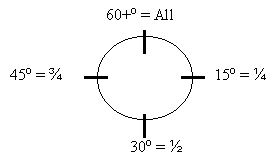| Heading | Timing | Back to Nav Techniques |
The Max Drift Navigation Technique
We can get the forecast wind from the Met Office and ATC but how can we apply it to our tracks to find initial headings to fly without using a computer? We can use the worst-case drift for the heading based on the wind and the 1 in 60 Rule – this is the basic Maximum Drift Technique. To explain how we do this read on..
Well if we were flying at 60 knots we would cover 60 nautical miles in an hour wouldn’t we? If the wind were 10 kts we would be blown 10 miles in an hour. Therefore, if we flew 90 degrees to the wind we would have 10 degrees drift as we would be 10 miles downwind and we would have covered 60 miles (1 in 60 gives 10º drift). This figure is our maximum drift because a wind at less than 90º off the track reduces the crosswind component and therefore the drift - it becoming a head or tail wind component.
What about ac speed?
If we were flying at 90 kts we would travel 1.5 times the 1 in 60 benchmark distance so our drift angle would be reduced (10 divided by 1.5 equals 7º give or take). It is easier to convert your speed to Nm per minute.
- 60 Kts = 1 Nm per minute, 90 = 1.5 Nm per minute, 120 = 2 Nm per minute and so on.
We then apply the very simple calculation of:
- Max Drift = wind speed / airspeed in Nm per min
Why max drift, well because the wind is all across and can only diminish in strength, head or tail components, and therefore we know that our calculated heading will put us up-wind.
The wind is rarely on the beam, so what next?
We could fly the whole route using maximum drift but we should improve the accuracy by factoring the drift for each track or leg. We can work out the drift applicable to each track if we know the angle of the wind off the beam, ie the amount of the drift, head and tail wind components for each leg.
Trigonometry dictates that between 60 and 90º the sin of an angle approximates 1 (60º = 0.87). At 45º ¾ (0.7), 30º ½ (0.5) and finally at 15º ¼ (0.26).
If we relate this to the clock code we have an easy way to
remember how much of the max drift value to apply on a leg.
15º = quarter past therefore ¼ the drift,
30º = half past therefore half the drift 45º ¼ to therefore ¾ the drift, 60º or
more off apply all the drift.

For example:
- Aircraft speed 90 Kts or 1.5 Nm per min
Wind 270/10 = 10/1.5 = 7º max drift
Track 240 or 30º off = 7º x ½ = 3.5º (4 for government work) drift into wind.
Heading = 244.
Clever so far, don’t be put off by the approximations after
all how accurate is the wind forecast at the height you are flying and how
accurate is your compass/DI or flying?
Timing with Max Drift Technique
The easiest way to run timing on a leg planned max drift is
to plan still air times. At planned "fix" points
a third or a quarter of the way along the leg make an accumulative correction
ie:
If the first fix is a quarter of the way down the route and
expected at 5:30 in still air, then if we arrive at the fix at 6 mins we are 30
seconds late after ¼ of the leg.
Therefore you would be 1 min late at halfway, 1:30 secs at ¾ and 2
minutes at the end of the leg.
However, you can help your flying by making a guestimate of
the ground speed during planning by using simple maths and the clock code once
again. If the wind was from the 12
o’clock then ground speed = airspeed – wind speed.
If the wind is from the beam then the head or tail wind
effect is zero. Therefore, using the
clock code we can work from the beam and factor the head or tail component. Eg
Hdg 270o, wind 300o then the beam = 360o and therefore the wind is 60º off the beam. Consequently all the wind taken as head wind.
Hdg 270o, wind 340o then the beam = 360o so the wind = 20º off the beam = ½ headwind (always round up).
For now lets assume that IAS = TAS then:
Ground speed = airspeed – head/tail wind component.
This will provide us with a groundspeed for our log-card
that we can then use to determine the times for the fixes. When applied to all legs, the timing error
will be reduced to levels hidden by the flying inaccuracies of most pilots.
The Max Drift technique and the groundspeed rules based on
trigonometry and the clock code are workable approximations for
navigation. Given that we are limited
in the visibilities we fly VFR, the errors are far less than the limits of the
VFR visibility and so, provided you look out, you will see the turning
point/destination/fix.